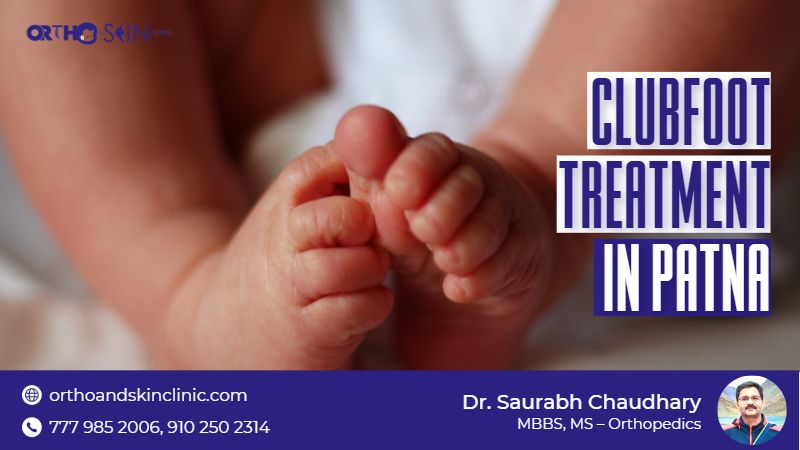In today’s article, we are going to tell you everything about clubfoot and its treatment. So, be with us till the last of this article to know everything about it.
Let us get started.
What is Clubfoot?
Clubfoot is a foot disorder that is usually present at birth in which a child’s foot is twisted or then inward and downward and remain firm in this position.
This is a congenital foot deformity that leaves a negative impact on a child’s bones, blood vessels, tendons (tissue connecting muscles and bones), and muscles.
Clubfoot is a common birth disorder that occurs in about one per thousand births and it is twice as common in boy children.
In clubfoot either one or both feet might be affected and may not look alike, and also it may be rigid or flexible.
Types of Clubfoot
Clubfoot is classified into three different types, those are as follows:
- Idiopathic Clubfoot
- Neurogenic Clubfoot
- Syndromic Clubfoot
Let’s look at each of them one by one.
#1. Idiopathic Clubfoot
Idiopathic clubfoot is also famous with the name talipes equinovarus and is the most common type of clubfoot present in children at birth. There is still not any cause found which can lead to idiopathic clubfoot but it has been seen that baby boys are twice likely to have this type of clubfoot as compared baby girls.
#2. Neurogenic Clubfoot
Neurogenic clubfoot is a type of clubfoot that can be caused by a condition of the nervous system. For instance, clubfoot can develop later in children who are born with spina bifida, cerebral palsy, or spinal cord compression.
#3. Syndromic Clubfoot
Syndromic clubfoot can be caused because of some medical conditions which are related to an underlying syndrome such as arthrogryposis, tibial hemimelia, constriction band syndrome, and diastrophic dwarfism.
Now you know about clubfoot and its types. So let us proceed further in this article where we will talk about clubfoot symptoms and risk factors.
What are the Symptoms of Clubfoot?
The following are the symptoms of clubfoot:
- Affected left might be shorter
- The foot looks as if it is upside down
- The calf muscled off the affected leg is underdeveloped
- The top of the foot is twisted downward and inward which increases the arch and turns the heel inward
What are the Risk Factors of Clubfoot?
The following are the risk factors of clubfoot:
- Maternal smoking during pregnancy
- Genes which means having a parent or sibling with clubfoot
- A congenital condition such as spina bifida
- Not enough amniotic fluid during pregnancy
- What are the long-term effects of clubfoot?
- If you ignore clubfoot in your child and don’t treat it then it can lead to more serious problems which include:
- Arthritis
- Inability to walk normally
- Poor self-image
- The problem stemming from walking adjustments
So, this is the exact reason why it is better to treat clubfoot in its initial days only, for this you can contact Dr, Saurabh Chaudhary, as he is one of the best orthopaedists in Bihar who can treat clubfoot of your child.
What is the Treatment for Clubfoot?
Following are the treatment for clubfoot that your orthopaedist might suggest, you can also visit Dr. Saurabh Chaudhary as he is best to provide clubfoot treatment in Patna, Bihar:
#1. Massage and cast
Massage and cast is a mild clubfoot treatment and best for clubfoot baby treatment as their tendons, ligaments, and bones are flexible and can easily be put in the correct position. This clubfoot treatment includes a gentle massage and manipulation to stretch tissue that has to tighten up after that a cast is applied to keep the position in place.
These casts can be removed and reapplied until your doctor feels that it is enough to correct but it usually takes at least 7 to 8 weeks.
#2. Clubfoot surgery
Clubfoot can also be treated with surgery which is known with the name of tenotomy. This clubfoot surgery can either be done in a clinic without anesthesia or in an operating room with anesthesia.
Tenotomy is done on the Achilles tendon and after surgery, this tendon will heal and reattach within 2 to 3 weeks, then after removing the last cast baby will be fitted with a special splint which will help to prevent relapse. Baby needs to wear this splint for several months 23 hours a day and after that at night or during naps for another 2 to 4 years.
Clubfoot Treatment Success Rate
Dr. Saurabh Chaudhry recommends starting treatment in the initial days which means within the first three weeks after the birth. If you treat clubfoot in its beginning then it has a success rate of greater than 90 percent.
So what are you thinking for go and consult your doctor so that your child can able to lead a normal life.


Leave a Reply